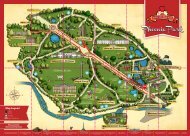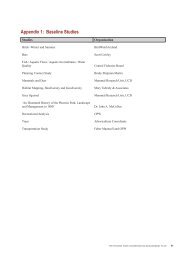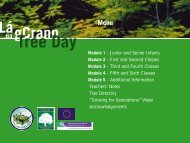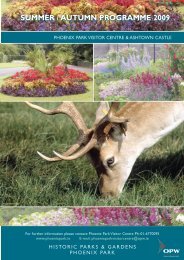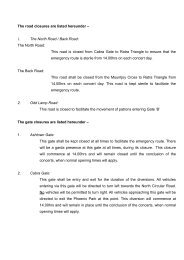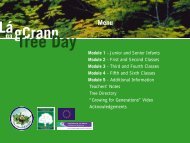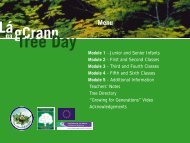The Birds of the Phoenix Park, County Dublin: Results of a survey in ...
The Birds of the Phoenix Park, County Dublin: Results of a survey in ...
The Birds of the Phoenix Park, County Dublin: Results of a survey in ...
Create successful ePaper yourself
Turn your PDF publications into a flip-book with our unique Google optimized e-Paper software.
species is highly congregatory, and regularly features among <strong>the</strong> most abundant species recorded<br />
dur<strong>in</strong>g both <strong>the</strong> CBS and BirdWatch Ireland’s w<strong>in</strong>ter Garden Bird Survey (GBS).<br />
• Sparrows – House Sparrow was surpris<strong>in</strong>gly scarce dur<strong>in</strong>g this <strong>survey</strong>; almost all were recorded (<strong>in</strong><br />
flocks <strong>of</strong> between 6 and 33 birds) <strong>in</strong> one <strong>of</strong> <strong>the</strong> Zoo sections (NE13), with <strong>the</strong> exception <strong>of</strong> section<br />
NE10 (polo grounds) where three were recorded dur<strong>in</strong>g one <strong>of</strong> <strong>the</strong> summer visits. This noisy and<br />
gregarious species is especially prevalent around human habitation. <strong>The</strong>y nest <strong>in</strong> holes <strong>in</strong> build<strong>in</strong>gs,<br />
and can also be seen congregat<strong>in</strong>g <strong>in</strong> large numbers areas where wall-climb<strong>in</strong>g plants are available<br />
for roost<strong>in</strong>g. <strong>The</strong>y are <strong>of</strong>ten present where food (seed and scraps) is provided. House Sparrow is<br />
consistently ranked among <strong>the</strong> top-20 most recorded species dur<strong>in</strong>g <strong>the</strong> GBS, recorded <strong>in</strong> 80% <strong>of</strong><br />
gardens (Crowe 2005).<br />
• F<strong>in</strong>ches – Eight species were recorded, <strong>in</strong>clud<strong>in</strong>g <strong>the</strong> w<strong>in</strong>ter visitor Brambl<strong>in</strong>g, which is highly<br />
scarce <strong>in</strong> Ireland. It is likely that most <strong>of</strong> <strong>the</strong> Sisk<strong>in</strong>s recorded were also w<strong>in</strong>ter visitors, as <strong>the</strong>y were<br />
absent dur<strong>in</strong>g <strong>the</strong> summer <strong>survey</strong>, and <strong>the</strong> resident population which breeds and occurs year-round <strong>in</strong><br />
Ireland is small. Chaff<strong>in</strong>ch, Greenf<strong>in</strong>ch, Goldf<strong>in</strong>ch and Bullf<strong>in</strong>ch were all relatively widespread and<br />
abundant throughout <strong>the</strong> park. L<strong>in</strong>net and Redpoll were more scarce, and are unlikely to be breed<strong>in</strong>g<br />
<strong>in</strong> <strong>the</strong> park. L<strong>in</strong>net <strong>in</strong> particular is limited by <strong>the</strong> lack <strong>of</strong> arable weeds used for feed<strong>in</strong>g and hedges<br />
for nest<strong>in</strong>g, while nest<strong>in</strong>g Redpolls show a preference for birch and willow scrub. Like <strong>the</strong> House<br />
Sparrow, f<strong>in</strong>ches are generally prevalent where supplementary food is available. Most species with<strong>in</strong><br />
this group have fared particularly well over <strong>the</strong> past 10 years (Crowe 2005, Coombes et al. 2006),<br />
especially Goldf<strong>in</strong>ch. This species has only <strong>in</strong> relatively recent times begun to use food provided <strong>in</strong><br />
gardens (Glue 1996).<br />
Previous observations <strong>in</strong> <strong>the</strong> park have <strong>in</strong>dicated that a variety <strong>of</strong> o<strong>the</strong>r species may also be present. S.<br />
Geraty (<strong>in</strong> litt.) reported <strong>the</strong> presence <strong>of</strong> both Long-eared Owls Asio otus and Barn Owls Tyto alba. Both<br />
species are nocturnal and difficult to <strong>survey</strong>. Nei<strong>the</strong>r was recorded dur<strong>in</strong>g <strong>the</strong> present <strong>survey</strong>s, and no owl<br />
pellets were found dur<strong>in</strong>g searches. However, <strong>the</strong> <strong>Phoenix</strong> <strong>Park</strong> is well-known as a long-established place for<br />
Long-eared Owls. <strong>The</strong>re are many suitable areas for nest<strong>in</strong>g; <strong>the</strong>y usually nest quite high up <strong>in</strong> an already<br />
exist<strong>in</strong>g nest (<strong>of</strong> o<strong>the</strong>r larger species such as corvids or even Woodpigeons) <strong>in</strong> conifers, situated near open<br />
areas over which <strong>the</strong>y can hunt <strong>the</strong>ir prey (small mammals). It is also likely that Barn Owls occur, and<br />
possibly even nest, <strong>in</strong> <strong>the</strong> park. <strong>The</strong>y prefer scattered woods and rough grasslands (<strong>the</strong> latter for hunt<strong>in</strong>g<br />
over), and will nest <strong>in</strong> old tree holes and <strong>in</strong> barns and old build<strong>in</strong>gs.<br />
S. Geraty (<strong>in</strong> litt.) also reported <strong>the</strong> occurrence <strong>of</strong> K<strong>in</strong>gfisher Alcedo atthis at <strong>the</strong> Quarry Pond and <strong>the</strong> Zoo<br />
ponds. It is very possible that this species cont<strong>in</strong>ues to use <strong>the</strong> park waterbodies for feed<strong>in</strong>g (on small fish).<br />
However, <strong>the</strong>re is a lack <strong>of</strong> suitable nest<strong>in</strong>g banks <strong>in</strong> <strong>the</strong> park. Geraty also reported Light-bellied Brent Geese<br />
Branta bernicla hrota fly<strong>in</strong>g over <strong>the</strong> park. Ireland plays host to almost <strong>the</strong> entire population which breeds <strong>in</strong><br />
high-arctic Canada, and which has been expand<strong>in</strong>g considerably <strong>in</strong> recent years. <strong>The</strong>y are primarily coastal<br />
grazers, which prefer to feed on eelgrass and Enteromorpha spp. However, <strong>the</strong>ir numbers are now almost<br />
double what <strong>the</strong>y were 10 years ago, while <strong>the</strong>ir preferred food supply is becom<strong>in</strong>g <strong>in</strong>creas<strong>in</strong>gly limited.<br />
<strong>The</strong>refore, <strong>in</strong>creas<strong>in</strong>g numbers are be<strong>in</strong>g forced to feed elsewhere, and earlier, as <strong>the</strong> w<strong>in</strong>ter season<br />
progresses. As an alternative, <strong>the</strong> geese have become adept at feed<strong>in</strong>g on short grass, and show preference<br />
for parks and pitches. It is highly likely that <strong>Phoenix</strong> <strong>Park</strong> grasslands would be suitable, and may well be<br />
used by feed<strong>in</strong>g geese <strong>in</strong> future w<strong>in</strong>ters.<br />
It was perhaps surpris<strong>in</strong>g that Reed Bunt<strong>in</strong>g Emberiza schoen<strong>in</strong>culus was not recorded. This species has<br />
formerly bred <strong>in</strong> <strong>the</strong> Zoo grounds (S. Geraty <strong>in</strong> litt., P. Phillips pers. obs.). It typically nests and forages <strong>in</strong><br />
rank and emergent vegetation, but also occasionally <strong>in</strong> some farmland habitats (uncropped tussocky grass,<br />
cereal crops, oil-seed rape or set-aside).<br />
Variation <strong>in</strong> species diversity and abundance throughout <strong>the</strong> park<br />
<strong>The</strong>re was considerable variation <strong>in</strong> bird species richness and abundance throughout <strong>the</strong> <strong>Phoenix</strong> <strong>Park</strong> dur<strong>in</strong>g<br />
both <strong>the</strong> summer and w<strong>in</strong>ter <strong>survey</strong>s. It is not too surpris<strong>in</strong>g that <strong>the</strong> sections with waterbodies supported <strong>the</strong><br />
greatest diversity and abundance <strong>of</strong> birds, given <strong>the</strong> relatively high numbers <strong>of</strong> waterbird species present,<br />
most <strong>of</strong> which are entirely dependent on waterbodies, and are highly congregatory.<br />
It is likely that <strong>the</strong> large numbers <strong>of</strong> ducks and Black-headed Gulls recorded with<strong>in</strong> <strong>the</strong> Zoo grounds at least<br />
partially resulted <strong>in</strong> <strong>the</strong> high densities recorded <strong>in</strong> <strong>the</strong>se sections. However, numbers <strong>of</strong> most o<strong>the</strong>r nonwetland<br />
bird species were also more abundant around <strong>the</strong> Zoo, especially Starl<strong>in</strong>gs, Feral Pigeons, Jackdaws<br />
11




